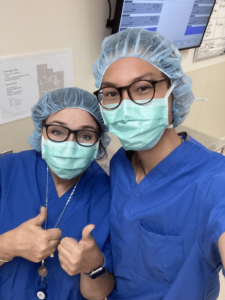my experience
Research Skills
1. Usability Testing
2. UX Research
3. Heuristic Evaluations
4. Ergonomic Assessments
5. Statistical Analysis
6. Quantitative UX Methods (user performance, A/B testing, benchmarking)
7. Qualitative UX Methods (interviews, surveys, observational analysis, thematic analysis)
Technology Skills
1. Python
2. SPSS
3. Figma
4. PsyToolKit
5. PsychoPy
6. Qualtrics
7. SurveyMonkey
8. Microsoft 365
9. Smartsheet
10. Airtable
Management Skills
1. Project Management/Governance
2. Stakeholder Management
3. User recruitment and management
4. Budgeting
5. Proposal Writing & Evaluation
6. Business Strategy
7. Mediation & Facilitation
Detailed narratives of my experience can be found below.
Human Factors Engineering Intern @ Dynamic Research, Inc.

At DRI, I carry out human factors research projects for a Fortune 10 car manufacturer working alongside simulation engineers. The projects involve applied human factors research including the initial conception of a research study, data collection and validation, qualitative and quantitative analyses, and technical report writing/presentations. I have experience working with DRI’s driving simulators as well as running “over-the-road” studies, collecting data in real life driving scenarios on public roads.
The projects that I have worked on thus far include studies regarding drivers’ emotions, driver to driver communication, comparing traditional vs. non-traditional headlights, driver safety monitoring systems, and usability testing of a mobile app. Due to my compliance with DRI’s non-disclosure agreement, I am only able to describe the projects at the high level described above.
Aside from my primary projects, I assist product development engineers and the assembly team in the production of some of DRI’s products that are used internationally for ADAS system testing in automobiles as well as using instructional design to optimize manufacturing processes for the assembly team.

Ergonomics Intern @ Mid-Atlantic Permanente Medical Group (MAPMG) | Kaiser Permanente
During the summer of 2024, I had the opportunity to serve the physicians of the Mid-Atlantic Permanente Medical Group (MAPMG) | Kaiser Permanente.
Working alongside the Senior Program Manager of Ergonomics, I applied physical ergonomics and anthropometric data to optimize the workstations of all physicians who reported pain or discomfort across the 61 medical office buildings in the Washington D.C., Virginia, and Maryland area. This included conducting ergonomic evaluations in physicians’ offices, exam rooms, and operating rooms. The ergonomic evaluations consisted of consulting with physicians to identify where they were experiencing pain/discomfort, conducting a task/procedural analysis, and redesigning or retrofitting their workstations using ergonomic equipment. For example, I conducted a task/procedural analysis for an ophthalmologist while they performed an eye cataract surgery. Through these ergonomic evaluations and retrofitting of medical office building facilities, I contributed to the longevity of MAPMG’s physician’s careers by preventing the development of musculoskeletal disorders and increasing physician efficiency.
In addition to conducting ergonomic evaluations, I designed a webinar curriculum for MAPMG’s Continuing Medical Education (CME) Program, where physicians attend webinars to add to their knowledge base. The CME I designed educated physicians about the importance of cognitive ergonomics, understanding Cognitive Load Theory, how to reduce extraneous cognitive load in healthcare, and the reality of multitasking and task switching. Supplementary to the ergonomic evaluations, I would also provide case-by-case recommendations to physicians whenever I saw an opportunity to reduce physicians’ cognitive load. By providing an understanding of cognitive ergonomics to physicians and minimizing cognitive load in their everyday operations, I contributed to reduced physician burnout and increased physician efficiency and performance.
Applying physical and cognitive ergonomic principles at MAPMG allowed me to leave my mark on the organization; particularly, by decreasing MAPMG’s physician rates of early retirement, turnover, and burnout, saving the organization time and money that would otherwise be needed for recruiting, onboarding, and training new physicians.
Similarly, I presented “Ergonomics Lunch & Learn” presentations to physicians to inform them about ergonomics as a solution to musculoskeletal pain and discomfort, ensuring that all physicians felt welcome to report their symptoms early and allowing our team to take action rapidly.
Assistant Program Manager @ the Los Angeles County Economic Development Corporation (LAEDC)
 Prior to joining the human factors job market, I worked as the Assistant Program Manager of a $600 million grant administered by the Employment Development Department (EDD) for the state of California called California Jobs First (CJF). The CJF initiative is a one-of-a-kind, community-driven economic development process, where human-centered thinking informs the development of strategic investments to create good quality jobs for disinvested communities. The project yielded one primary product – the Regional Plan for the Los Angeles region, where strategic investments and projects were proposed to the State of California to invest additional funds in Los Angeles County.
Prior to joining the human factors job market, I worked as the Assistant Program Manager of a $600 million grant administered by the Employment Development Department (EDD) for the state of California called California Jobs First (CJF). The CJF initiative is a one-of-a-kind, community-driven economic development process, where human-centered thinking informs the development of strategic investments to create good quality jobs for disinvested communities. The project yielded one primary product – the Regional Plan for the Los Angeles region, where strategic investments and projects were proposed to the State of California to invest additional funds in Los Angeles County.
As Assistant Program Manager, I was responsible for managing all aspects of the program to ensure all deliverables were met on time. This included working with a diverse group of over 700 stakeholders across the Los Angeles region including government agencies, community-based organizations, employers and business associations, labor organizations, academia, and more. I worked under a high-pressure, public-facing environment and was often challenged with facilitating this massive planning process while effectively mediating and managing stakeholders with opposing interests. My tenure as Assistant Program Manager allowed me to become comfortable with contentious, high stakes situations and working with a large, diverse team with competing interests to synthesize a cohesive end product.
To learn more about my work on the California Jobs First initiative, visit https://lacerf.org/.
